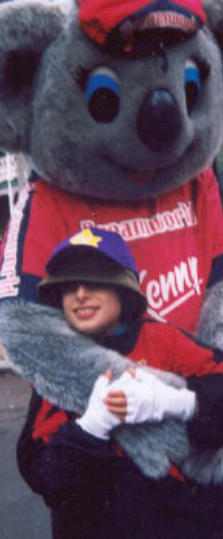Click here to donate to
The Friends of Sammy-Joe
Foundation
Click here to visit Sammy-Joe’s
Fundraising Shop at Cafepress.

Make A Donation

Fundraising Shop
© The Friends of Sammy-Joe Foundation

GOFUNDME

Social Media

Web Site by VP-IT



DONATE NOW
VIA GOFUNDRAISE
Please click the logo or
button below to visit our
GoFundraise page
Thank you so much
for your support.



GOFUNDRAISE

Entertainment™ Memberships
include over $20,000 worth of
valuable 2-for-1 & up to 50% off
offers from many of the best
restaurants, arts, attractions,
hotel accommodation, travel
& much more!
Books can be purchased directly
from Maria or ordered online.
Alternatively, there is an
app available.
The books are $70 each.

SUPPORT FRIENDS OF
SAMMY-JOE - BUY AN
ENTERTAINMENT™ BOOK!
A page has been set up on
GoFundMe to help Sammy-Joe
with his medical needs - the costs
are so high and the family is
struggling. Please help by donating.
We need to provide funds for over
the counter medications and
expensive prescription drugs that
are not covered by the PBS.
Please click here to donate.
Thank you so much
for your support.
Sammy-Joe with mum Maria
What is Trichothiodystrophy?
Trichothiodystrophy (TTD) is a rare genetic disorder that involves the
production of abnormal brittle hair, icthyosis, and physical and
developmental disorders. It can also involve ataxia, stunted growth, and
skin sensitivity to light and UV rays.
TTD is a seriously disabling disorder with a severe skin affliction and
serious developmental defects and growth retardation. It can also cause
immune deficit cells, premature aging in facial features, cataracts and
dental abnormalities, poor weight gain, autistic characteristics such as
irritation to high frequency sounds, and repetitive movements and
behaviours.
It is one of a group of diseases - the others being xeroderma
pigmenentusm and cockayne syndrome. It is a rare and recessive
disorder, and patients can be characterised by symptoms of sulphur
deficient hair, and in about 80% of cases, photosensitivity. There have
been no reports of association with skin cancers, but patients have
been known to have short life expectancy.
Diagnosis is made by studying the hair mounts, and by amino acid
analysis which demonstrates decreased high sulphur matrix proteins.
The hair is so brittle that once it emerges from the skin and becomes
exposed to the environment, the hair breaks and fractures, and so the
result is brittle, short and sparse hair. This is why most of the children
with TTD have sparse eyebrows and eyelashes.
There is currently no treatment for TTD.
How TTD can affect your child
TTD is a life-limiting condition. There is no specific life expectancy, as it
will depend on the severity of your child’s condition.
TTD has some physical characteristics which are often similar across
many affected patients.
•
Height – this will depend on the severity of their condition.
•
Brittle hair and nails – these will flake and break easily.
•
Ichthyosis (thick, dry skin) – your child will shed skin at a faster rate
than usual and will need a regular moisturising routine.
•
Your child may have congenital (from birth) cataracts – these are
often surgically removed.
Your child’s hearing and sight may be affected. This can often be
managed with glasses and hearing aids.
People with TTD are more at risk from tooth decay, so particular care
needs to be taken with oral hygiene and making sure that a healthy diet
is followed.
A reduced immune system is also a common problem for patients with
TTD. This means that patients are more likely to get infections, so extra
care needs to be taken, especially during the winter months when there
is an increased risk of chest infections.
Your child may have problems with eating and drinking. These can be
managed in several different ways ranging from thickening oral fluids, to
a gastrostomy (a feeding tube into the stomach). The options will
depend on the advice of the doctors.
Photosensitivity (sensitivity to the sun) and photophobia (sensitivity to
light) can be an issue for patients with TTD. High factor (50+) sunscreen
should be used if they are going out but, where possible, you should try
to keep your child in the shade. Make sure that sunshades are used on
car windows, where appropriate. In severe cases, special film will need
to be placed on the windows at home and in the car to make sure that
no UV is present. Sunglasses will be necessary, maybe even indoors, if
your child suffers with photophobia.
TTD will have an impact on your child’s developmental abilities. You
may have noticed that they are not reaching their milestones at the
same rate as other children. This will become more apparent as they
get older.
As with many other illnesses, there is a spectrum (range). Patients with
TTD will all have very similar attributes, but the severity of the condition
will vary depending on how the genes are affected.
PLEASE HELP!!
A ‘Friends Of Sammy-Joe’ donation charity tin
was recently stolen from a pharmacy in Craigieburn.
Please help us to find the thief.
Click here to visit 9 News to read more
Click here to read more also
Click here to read Hume Leader’s article on the
community stepping up to help
Click here to read a post by Maria Vamvakinou MP
about Sammy-Joe & Trichothiodystrophy (TTD)
Now Available:
Turi Trust Charity Documentary - click here to watch (YouTube)
Visit Us On:























